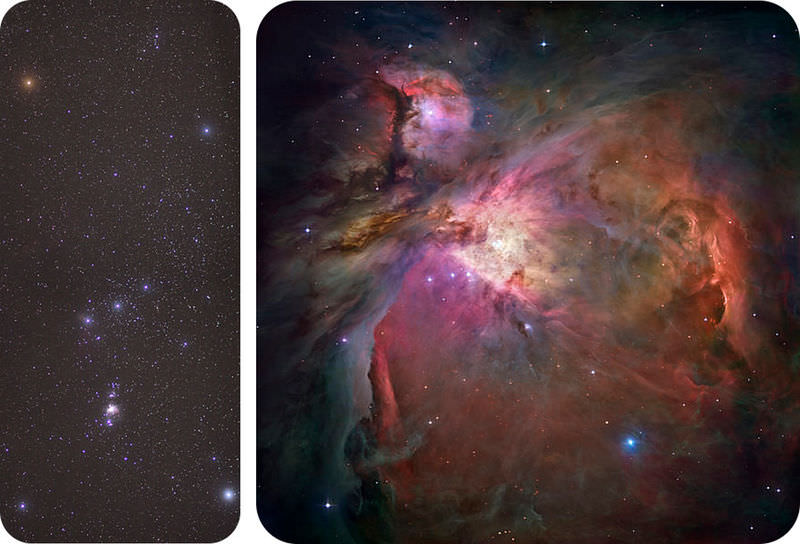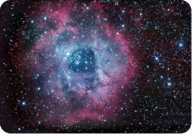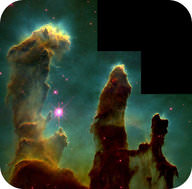23.4: Star Formation
- Page ID
- 6237
\( \newcommand{\vecs}[1]{\overset { \scriptstyle \rightharpoonup} {\mathbf{#1}} } \)
\( \newcommand{\vecd}[1]{\overset{-\!-\!\rightharpoonup}{\vphantom{a}\smash {#1}}} \)
\( \newcommand{\id}{\mathrm{id}}\) \( \newcommand{\Span}{\mathrm{span}}\)
( \newcommand{\kernel}{\mathrm{null}\,}\) \( \newcommand{\range}{\mathrm{range}\,}\)
\( \newcommand{\RealPart}{\mathrm{Re}}\) \( \newcommand{\ImaginaryPart}{\mathrm{Im}}\)
\( \newcommand{\Argument}{\mathrm{Arg}}\) \( \newcommand{\norm}[1]{\| #1 \|}\)
\( \newcommand{\inner}[2]{\langle #1, #2 \rangle}\)
\( \newcommand{\Span}{\mathrm{span}}\)
\( \newcommand{\id}{\mathrm{id}}\)
\( \newcommand{\Span}{\mathrm{span}}\)
\( \newcommand{\kernel}{\mathrm{null}\,}\)
\( \newcommand{\range}{\mathrm{range}\,}\)
\( \newcommand{\RealPart}{\mathrm{Re}}\)
\( \newcommand{\ImaginaryPart}{\mathrm{Im}}\)
\( \newcommand{\Argument}{\mathrm{Arg}}\)
\( \newcommand{\norm}[1]{\| #1 \|}\)
\( \newcommand{\inner}[2]{\langle #1, #2 \rangle}\)
\( \newcommand{\Span}{\mathrm{span}}\) \( \newcommand{\AA}{\unicode[.8,0]{x212B}}\)
\( \newcommand{\vectorA}[1]{\vec{#1}} % arrow\)
\( \newcommand{\vectorAt}[1]{\vec{\text{#1}}} % arrow\)
\( \newcommand{\vectorB}[1]{\overset { \scriptstyle \rightharpoonup} {\mathbf{#1}} } \)
\( \newcommand{\vectorC}[1]{\textbf{#1}} \)
\( \newcommand{\vectorD}[1]{\overrightarrow{#1}} \)
\( \newcommand{\vectorDt}[1]{\overrightarrow{\text{#1}}} \)
\( \newcommand{\vectE}[1]{\overset{-\!-\!\rightharpoonup}{\vphantom{a}\smash{\mathbf {#1}}}} \)
\( \newcommand{\vecs}[1]{\overset { \scriptstyle \rightharpoonup} {\mathbf{#1}} } \)
\( \newcommand{\vecd}[1]{\overset{-\!-\!\rightharpoonup}{\vphantom{a}\smash {#1}}} \)
\(\newcommand{\avec}{\mathbf a}\) \(\newcommand{\bvec}{\mathbf b}\) \(\newcommand{\cvec}{\mathbf c}\) \(\newcommand{\dvec}{\mathbf d}\) \(\newcommand{\dtil}{\widetilde{\mathbf d}}\) \(\newcommand{\evec}{\mathbf e}\) \(\newcommand{\fvec}{\mathbf f}\) \(\newcommand{\nvec}{\mathbf n}\) \(\newcommand{\pvec}{\mathbf p}\) \(\newcommand{\qvec}{\mathbf q}\) \(\newcommand{\svec}{\mathbf s}\) \(\newcommand{\tvec}{\mathbf t}\) \(\newcommand{\uvec}{\mathbf u}\) \(\newcommand{\vvec}{\mathbf v}\) \(\newcommand{\wvec}{\mathbf w}\) \(\newcommand{\xvec}{\mathbf x}\) \(\newcommand{\yvec}{\mathbf y}\) \(\newcommand{\zvec}{\mathbf z}\) \(\newcommand{\rvec}{\mathbf r}\) \(\newcommand{\mvec}{\mathbf m}\) \(\newcommand{\zerovec}{\mathbf 0}\) \(\newcommand{\onevec}{\mathbf 1}\) \(\newcommand{\real}{\mathbb R}\) \(\newcommand{\twovec}[2]{\left[\begin{array}{r}#1 \\ #2 \end{array}\right]}\) \(\newcommand{\ctwovec}[2]{\left[\begin{array}{c}#1 \\ #2 \end{array}\right]}\) \(\newcommand{\threevec}[3]{\left[\begin{array}{r}#1 \\ #2 \\ #3 \end{array}\right]}\) \(\newcommand{\cthreevec}[3]{\left[\begin{array}{c}#1 \\ #2 \\ #3 \end{array}\right]}\) \(\newcommand{\fourvec}[4]{\left[\begin{array}{r}#1 \\ #2 \\ #3 \\ #4 \end{array}\right]}\) \(\newcommand{\cfourvec}[4]{\left[\begin{array}{c}#1 \\ #2 \\ #3 \\ #4 \end{array}\right]}\) \(\newcommand{\fivevec}[5]{\left[\begin{array}{r}#1 \\ #2 \\ #3 \\ #4 \\ #5 \\ \end{array}\right]}\) \(\newcommand{\cfivevec}[5]{\left[\begin{array}{c}#1 \\ #2 \\ #3 \\ #4 \\ #5 \\ \end{array}\right]}\) \(\newcommand{\mattwo}[4]{\left[\begin{array}{rr}#1 \amp #2 \\ #3 \amp #4 \\ \end{array}\right]}\) \(\newcommand{\laspan}[1]{\text{Span}\{#1\}}\) \(\newcommand{\bcal}{\cal B}\) \(\newcommand{\ccal}{\cal C}\) \(\newcommand{\scal}{\cal S}\) \(\newcommand{\wcal}{\cal W}\) \(\newcommand{\ecal}{\cal E}\) \(\newcommand{\coords}[2]{\left\{#1\right\}_{#2}}\) \(\newcommand{\gray}[1]{\color{gray}{#1}}\) \(\newcommand{\lgray}[1]{\color{lightgray}{#1}}\) \(\newcommand{\rank}{\operatorname{rank}}\) \(\newcommand{\row}{\text{Row}}\) \(\newcommand{\col}{\text{Col}}\) \(\renewcommand{\row}{\text{Row}}\) \(\newcommand{\nul}{\text{Nul}}\) \(\newcommand{\var}{\text{Var}}\) \(\newcommand{\corr}{\text{corr}}\) \(\newcommand{\len}[1]{\left|#1\right|}\) \(\newcommand{\bbar}{\overline{\bvec}}\) \(\newcommand{\bhat}{\widehat{\bvec}}\) \(\newcommand{\bperp}{\bvec^\perp}\) \(\newcommand{\xhat}{\widehat{\xvec}}\) \(\newcommand{\vhat}{\widehat{\vvec}}\) \(\newcommand{\uhat}{\widehat{\uvec}}\) \(\newcommand{\what}{\widehat{\wvec}}\) \(\newcommand{\Sighat}{\widehat{\Sigma}}\) \(\newcommand{\lt}{<}\) \(\newcommand{\gt}{>}\) \(\newcommand{\amp}{&}\) \(\definecolor{fillinmathshade}{gray}{0.9}\)Can you see stars being born?
On a dark night you can practically watch stars being born. The fuzzy area in the sword in the constellation Orion is the Orion nebula. A close up shows the nebula with around 3,000 stars. New stars are being born there.
Star Lives
Stars have a life cycle, just like people. Stars are born, grow, change over time, and eventually grow old and die. Most stars change in size, color, and class at least once in their lifetime. What astronomers know about the life cycles of stars comes from data gathered from visual, radio, and X-ray telescopes.
Nebulae
Stars are born in a cloud of gas and dust called a nebula (Figure below). Our Sun and solar system formed out of a nebula.
Stars are forming in the Rosette Nebula.
The Pillars of Creation (Figure below) are within the Eagle Nebula. The pillars are thought to be a large region where stars are forming. The dark areas may be stars that are about to begin.
In the Pillars of Creation, gas and dust come together as a stellar nursery.
Star Formation
For a star to form, gravity pulls gas and dust into the center of the nebula. As the material becomes denser, the pressure and the temperature increase. When the temperature of the center becomes hot enough, nuclear fusion begins. The ball of gas has become a star!
Our Sun was probably born in a nebula, like Orion in the top image.
Summary
- Stars form in a nebula.
- A nebula is a cloud of dust and gas.
- Nebulae can be spotted with the naked eye or simple telescopes.
Review
- What is a nebula?
- How do stars form?
- Why do scientists think the Pillars of Creation are where stars are forming?
References
| Image | Reference | Attributions |
|---|---|---|
 |
[Figure 1] |
Credit: Courtesy of NASA, Jeff Hester, and Paul Scowen (Arizona State University);By Tyrogthekreeper at English Wikipedia, CC BY-SA 3.0, commons.wikimedia.org/w/inde...10273;Courtesy of H. Bond (STScI), and M. Barstow (University of Leicester), NASA/ESA Source: commons.wikimedia.org/wiki/File:Eagle_nebula_pillars.jpg ; By Tyrogthekreeper at English Wikipedia ; CC BY-SA 3.0 ; commons.wikimedia.org/w/index.php?curid=18110273 ; commons.wikimedia.org/wiki/File:Sirius_A_and_B_Hubble_photo.jpg License: Public Domain |
 |
[Figure 2] |
Credit: John Lanoue;CC BY-SA 3.0, commons.wikimedia.org/w/inde...ry/622142.html Source: commons.wikimedia.org/wiki/File:Rosette_nebula_Lanoue.png ; CC BY-SA 3.0 ; commons.wikimedia.org/w/index.php?curid=230867 ; http://keywordsuggest.org/gallery/622142.html License: Public Domain |
 |
[Figure 3] |
Credit: Courtesy of NASA, Jeff Hester, and Paul Scowen (Arizona State University);CC BY-SA 3.0, commons.wikimedia.org/w/inde...urid=230867;By Credit: NASA, Jeff Hester, and Paul Scowen (Arizona State University) - http://hubblesite.org/newscenter/new...003/34/image/a, Public Domain, commons.wikimedia.org/w/inde...p?curid=129538 Source: commons.wikimedia.org/wiki/File:Eagle_nebula_pillars.jpg ; CC BY-SA 3.0 ; commons.wikimedia.org/w/index.php?curid=230867 ; By Credit: NASA ; Jeff Hester ; and Paul Scowen (Arizona State University) - http://hubblesite.org/newscenter/newsdesk/archive/releases/2003/34/image/a ; Public Domain ; commons.wikimedia.org/w/index.php?curid=129538 License: Public Domain |



